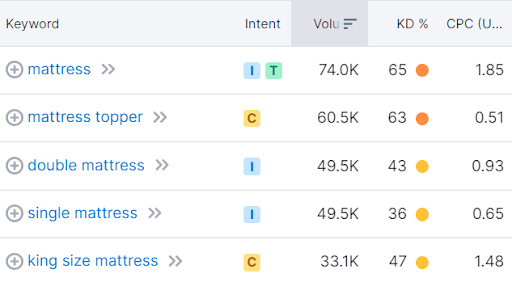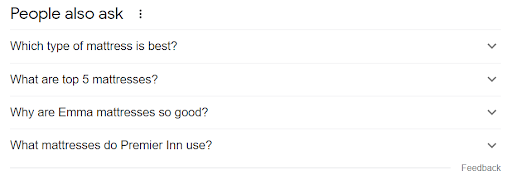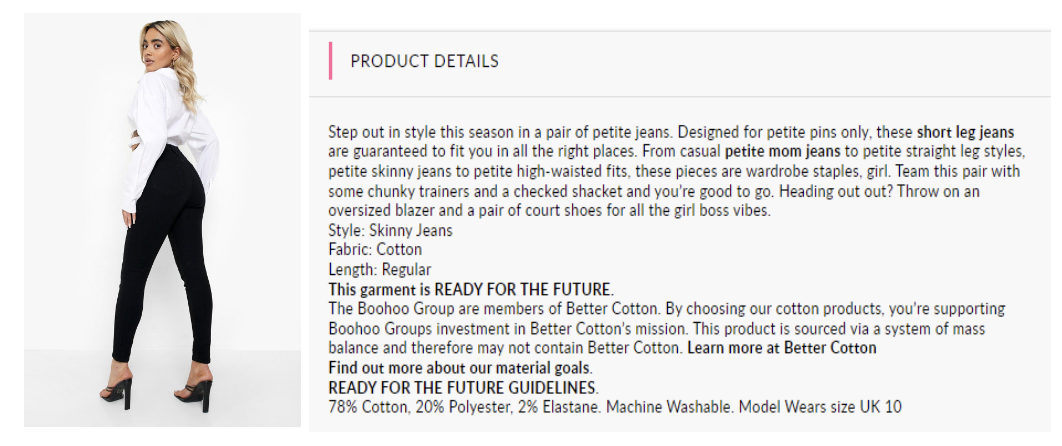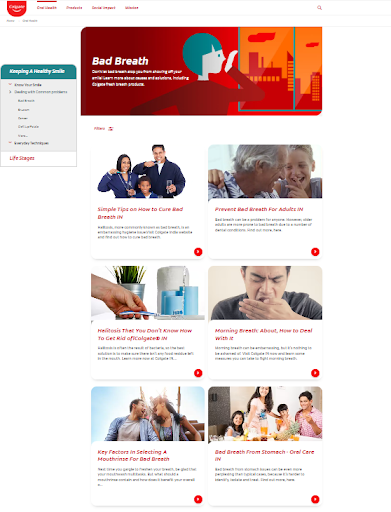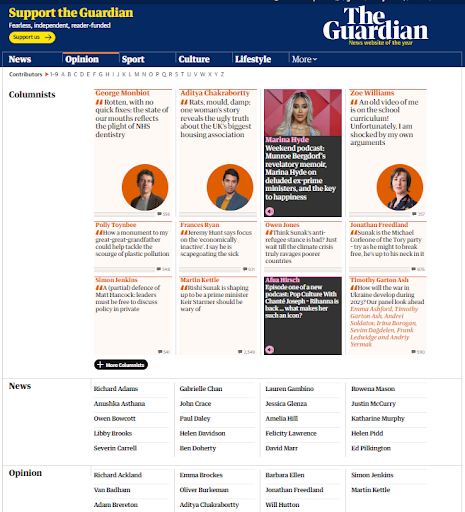Over time, Google, and other search engines have provided increased visibility for websites that offer their users ‘valuable’ or ‘good’ content. If you have an amazing product, but the content on the website fails to highlight its benefits, you’re not likely to achieve that all important sale. Great content can provide users with the information they need in order to aid them through their customer journey and increase conversions.
So what is ‘good’ content, and how can we go about writing content that search engines, and more importantly, your users will love? In this article we’ve put together some unforgettable tips on how to write great ecommerce content, to take your ecommerce website to that next level.
Benefits Of Writing Great Copy For eCommerce Brands
Firstly, let’s take a look at why providing your customers with great quality website content is so important.
Differentiates your brand – Through great product and category copy you can highlight what makes your brand different to set you aside from your competitors.
Increases sales – By highlighting your categories and product benefits, it helps the user understand how your product will solve their problem. This will assist in increasing conversions and driving sales.
Conveys your brand tone – It helps convey the company you are, what’s important to you as a brand and your USPs.
Builds customer relationships – Writing compelling ecommerce content is essential in formulating a rapport with customers and gaining their trust whilst establishing relationships.
Increases organic performance – Back in February 2011 Google launched a ‘Panda’ update to their algorithm which focused on decreasing rankings for websites that provided ‘thin content’ and increasing rankings for this with ‘good’, ‘original’ content. By improving your website copy, you’re also improving the chances of increasing your website’s search engine rankings.
What To Consider Before Creating Your Content
Understand your Customers
In order to create content that resonates with your users, you need to understand who the content is for. Knowing your readers allows you to craft copy that they understand and can relate to, which speaks in their language. Think about who your target buyers are, what do they need and want and what struggles are they facing?
Social bookmarking websites and online boards like Reddit and Quora are great tools for analysing what your customers are discussing. Or check out some relevant industry forums where your audience will be participating in discussions, asking questions and researching key topics.
Understand search demand (by carrying out keyphrase research)
It’s essential to understand user search intent before creating your content, this involves carrying out detailed keyphrase research. Carrying out keyphrase research for ecommerce websites is slightly different as the main objective is to turn visitors into customers.
We believe there are 4 key steps when carrying out ecommerce keyphrase research:
- Understanding the buyer journey and how customers are using search engines
- Identifying the most relevant and high-performing keywords that your target audience uses when searching for your products or services
- Mapping keyphrases to landing pages based on search intent
- Segmenting your keyphrases into groups in order to start building your content clusters.
Through keyphrase analysis you can understand what your target audience is asking, identify key topics and optimise your content appropriately. This is one of the most crucial steps in planning your content.
Identify your Content Clusters and Subtopics
A content cluster is a network of content based on an overarching topic, which links out to relevant subtopics. Your core topic is the ‘pillar’ page and all your subtopics are linked out to as ‘cluster posts.’
For example, take the term ‘mattress’ if you just try to rank for that one head term, you’re not taking advantage of the full market opportunity. If you’re able to rank for ‘mattress’ as well as its longer tail variants, you’re able to rank for a wider number of phrases and thereby increase your visibility and traffic.
Image Source: SEMrush
There are some great tools available to help determine your clusters:
- Answer The Public which pulls from Google autocomplete, providing useful phrases and questions users are asking.
- Buzzsumo is a cloud-based platform that helps you determine the content with the most engagement, trending stories, customer questions etc. They provide a free trial, but the tool requires a paid subscription.
- Google Analytics – You can learn so much using GA. Not only what content is performing for ideas but other metrics to help plan out your content strategy, including:
- Content driving the most sessions,
- Visits from the most popular countries
- The days the site receives the most traffic
- Where your traffic comes from e.g. Facebook, direct, referral
- What device they use e.g. desktop, mobile (and model)
- SEMrush is a tool suite to improve online visibility and uncover marketing insights. Again, they offer a free trial, but this is a paid for subscription. The keyword tool can uncover keyword opportunities and commonly asked questions to identify content topics. Their content explorer can review the SERPs for recommended related topics too.
- People Also Ask – Google itself can provide you with so many insights. Not only from just reviewing the SERPs to see what’s ranking for your chosen topics but also the ‘People Also Ask’ feature.
See what questions have appeared for the term ‘mattress’:
Content clusters are like bucket pools of relevance. They help search engines understand context, relationships, and hierarchy. Not only that, they’ll help to reinforce your brand as a leader within a specific topic.
How To Create Valuable Content For Your Customers
So let’s get down to the nitty-gritty. How can we actually craft content that can help your brand stand out, and increase sales. Here are a few techniques:
Write Informative Product Descriptions
When a customer is visiting either your category or product pages, they are either carrying out research or intending to buy. In order to satisfy this user intent the product descriptions need to provide informative information. There’s an old saying ‘an image says a thousand words’ but this is not the case for good product descriptions, never rely on just your image.
If your product is a pair of jeans, provide information such as:
- Material
- Length
- Style
- Fabric
- Fit
But more importantly focus on the benefits and features, don’t just describe what it is, you need to really highlight how your product stands out and what makes it different. It could be ethically sourced materials, limited edition, high quality fabrics. Then consider how these benefits could enhance your customers.
Here’s a great example from boohoo for their recycled high waist skinny jeans:
What’s good about it?:
- Their language they use is familiar and relaxed, which helps resonate with their target audience. Not only that, it’s good quality, original, well-written content.
- They highlight the benefits (fits in all the right places)
- Provide an idea of who the product is perfect for and what you can wear it with
- You’re supporting Better Cotton’s mission, so it helps the user feel like they’re contributing to a good cause.
Well-written product descriptions are an essential tool to drive conversions. The Nielsen Norman Group conducted a survey that stated 20% of lack of purchase is due to absence of information in a product description, so it’s important to ensure they provide compelling and engaging information.
Build Topical Content Clusters
Like we mentioned previously, it’s best to set your content up into content pillars with inter-linked subtopics. Here is a great example from Colgate, using their content cluster focusing on bad breath. As you can see they link out to cluster posts such as:
- ‘Best mouthwash for bad breath’ (880 UK searches on average per month)
- ‘How To Tell if You Have Bad Breath’ (170 UK searches on average per month)
- ‘Morning Breath: Prevention, Treatment, Tips’ (580 UK searches on average per month)
Image Source: Colgate
As you can see from the above, every topic Colgate has written about is based on search demand. Also the way they’ve set up the page, with easy internal linking for users and enticing images, we think they’re doing a rather good job.
Bear in Mind Your Customer’s Pain Points
Surveys are a great tool to understand the problems and pain points your customers are facing. When crafting your content, keep your customers’ pain points and questions at the forefront of your mind and ensure you’re answering them when creating your content. Like previously mentioned, use social bookmarking sites, social media, forums too to help identify common FAQs.
Write Compelling Headlines
Headlines are essential in capturing your audience’s attention and creating a first impression. Which is why you need to make sure your headline stands out and captures your users. Headlines need to be consistent throughout your website, from the homepage, product pages, and through to other promotional content like emails too.
When creating headlines:
- Communicate what the page is
- Blear clear and concise
- Use your brand tone
- Use language your target audience will understand and relate to
Add Customer Testimonials
When used correctly, customer testimonials can be a really powerful tool, by adding an element of trust in your brand and validating your products.
For new customers, a glowing testimonial could provide you with that edge over your competitors, helping you build your brand’s credibility and leading to higher sales.
Testimonials can appear anywhere on your site. Ensure to list them on your homepage, through your blog content, product pages or even (and preferably) build a dedicated testimonial page.
Ensure Your Content is Detailed
If a user reads some poorly written content, consisting of a minimal amount of text, providing limited insight for a customer, they’re going to leave the website less likely to convert and feeling dissatisfied. Make sure that your content satisfies the users, and you’ve provided enough thorough information to answer their questions. Google’s algorithm rewards well-researched, well crafted and informative content, so you want to ensure you’re providing just that.
Add E-E-A-T Signals
At the end of 2022, Google updated their concept of E-A-T (expertise, authoritativeness, and trustworthiness) with an additional ‘E’ for experience. With this and a recent ‘Helpful Content Update’ it’s clear Google is continually striving to provide high quality content that’s written by experienced and qualified experts.
E-E-A-T is one of Google’s guidelines that allows them to establish whether content is of value to its readers. Although it’s not technically a ranking factor, it can still influence your ranking position in search results pages. There is actually a team of Google employees that spot check results to accurately determine if their algorithm is accurately recognising web page quality.
Here are a few tips to ensure your content is regarded as written by experienced writers and demonstrates expertise, authoritativeness and trustworthiness:
- Ensure your content is fresh, outdated content will struggle to rank. So review old content and regularly update it. Featuring the date of an article is considered important for getting into Google News
- Demonstrate your writer’s experience – this could be highlighted in the form of a bio of or via a designated author profile page. A profile page can easily highlight credentials, experience, credibility etc. Include a photo on the profile page with social media links in order to associate that person too. Large editorial sites like The Guardian do this well, detailing a ‘contributor page’ and having individual profiles set up for their columnists. You’re able to click on their profile and also view all their own articles and credentials.
Image Source: The Guardian
- Finally for further E-E-A-T signals: link out to credible sources, include image links, quotes from industry experts, include reference blocks where necessary.
Provide CTAs (Call-To-Actions)
A C-T-A on a website is an instruction to the user to encourage them to complete some form of action. If a user reads a piece of content, make it very clear what they need to do next, whether that’s add to basket, shop now, sign up, write a review etc. You’re essentially steering them to the most appropriate path down the conversion funnel.
Internally Link To Other Pages
Search engines are only able to find your pages if they’re linked to from other pages. Internal links will help to establish the hierarchy, making it clear what pages are the most important pages on your website and in turn help to increase your organic performance.
Aside from the benefits for search engines, internal links are important for users to navigate throughout the website. When creating content add internal links to help distribute link authority and establish relationships between content.
Other Considerations
To answer what makes a good piece of content there are so many factors to consider, some you might not even think about as they appear so obvious, but it’s important we highlight them here:
- Make sure it’s original content – Google will be able to tell if your content is duplicated or plagiarised.
- Ensure it’s well written, grammatically correct.
- Make sure sentences don’t go on forever, so it’s easy for users to read.
- Ensure it’s formatted and presented appropriately.
Conclusion
Now you’ve got the know-how, you can go about writing your ecommerce content. We hope that gives you enough simple pointers to create some fabulous content your users will love. Good luck.

